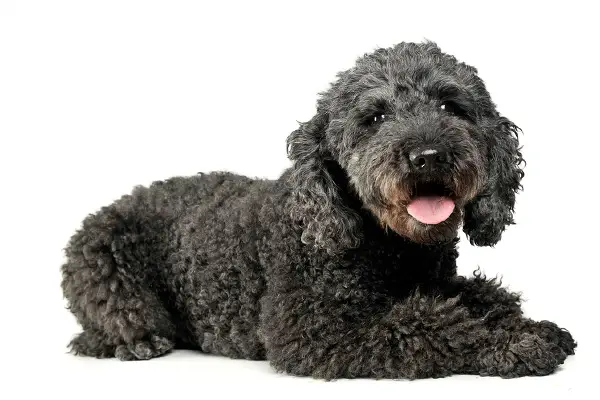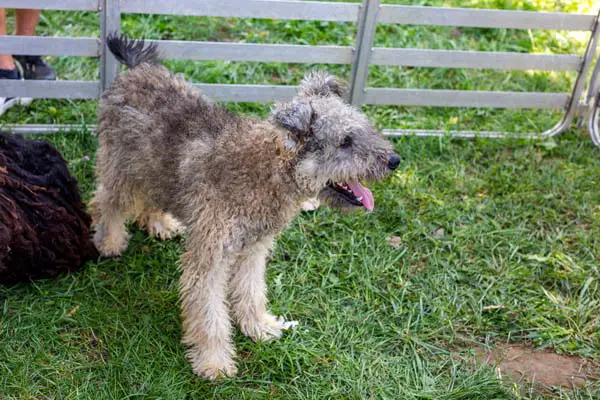The Pumi is a medium-sized dog from Hungary known for their curly coats. The breed also features a circular tail, erect ears, and a whimsical look. He almost resembles a teddy bear, and it’s undeniable that he is a cute breed.
Don’t get this dog just for the looks. The Pumi is a highly active dog, and he is best paired with people who can cope with him. These dogs are known to be adaptable in any living conditions, even in an apartment, given that you can fulfill his exercise needs.
These are people-oriented dogs, so they should be with people who can give him enough time, attention, and interaction. As much as they are significant play buddies during the day, they’ll be great cuddle buddies after a long day.

Pumi Statistics
| Dog Breed Group | Herding |
| Breed Size | Medium |
| Height | 16-18.5 inches (male); 15-17.5 inches (female) |
| Weight | 27-29 pounds (male); 22-24 pounds |
| Lifespan | 12-13 years |
Pumi Ratings
| Energy level | |
| Exercise needs | |
| Requires attention | |
| Playfulness | |
| Trainability | |
| Shedding | |
| Grooming | |
| Friendly with family | |
| Friendly with kids | |
| Friendly with strangers | |
| Friendly with other dogs | |
| Prey Drive |
Pumi History
The Pumi is a Hungarian dog that is believed to have existed more than 300 years ago. These dogs are one of the three original sheepdogs of Hungary, along with the Mudi and Puli. This is why it’s no wonder if you see quite a resemblance between the three.
Puli was the oldest among the three breeds. These dogs are believed to have been crossed with French and German herding dogs to create the Pumi. In comparison, Mudi was the last to be developed by crossing the Puli, Pumi, and German Spitz breeds.
For centuries, the Pumi was considered a variant of the Puli dog breed. It was only in the 1920s that he was declared a separate breed. By 1935, an international standard for the breed was finally written.
It was only in the year 2011 when the dogs were officially recognized in the United States, while they were recognized in the United Kingdom in 2015.
Now, the dogs are still considered rare in America. But it is known that the country with the most number of Pumis is in Finland and Sweden, while there are only more than 2,000 Pumis registered in Hungary.

Pumi Temperament
Pumis are energetic, lively, and ready to work dogs despite their plush-toy, adorable looks. They are fearless sheepherders, and this resulted in them having a strong desire to work.
If you allow a Pumi to be bored, you may have lots of problems when he’s indoors. So if you don’t have work to give him, keep him entertained with toys or play sessions so he can spend that extra energy.
Pumis may also be prone to separation anxiety especially if left alone for very long periods. They are people-oriented, and they love having human companionship.
If you have other dogs, this is better as they might help keep your Pumi entertained. But, keep small animals away. These dogs have a strong prey drive, and they might hunt down your little hamsters or rabbits.
They will also make great playmates for your children, given that you still keep close supervision. Remember, these are herding dogs, and if given an opportunity, they might try to herd your children.
Their innate guard dog personality may not make them too friendly with strangers. You can also expect them to be very vocal when someone suspicious comes to your home. So, if you want to keep your Pumi at a stable temperament, early socialization is a must.
Training may not also come easy because of their independent tendencies. But all you need is to be consistent, firm, and watch that you don’t spoil him too much. Also, positive reinforcements are very helpful to make him obey.
Care Requirements
- Nutrition: Pumis should do well on any type of diet as long as it’s high-quality and well-balanced. It’s also crucial that it’s appropriate to his size, age, and activity level, especially when it comes to their daily calorie requirements. When it comes to nutrition, it’s always best to ask your vet for a guide. You can also check if your dog is allergic to any food ingredient to stay away from those. If you plan to give him home-cooked meals or dog food, the only thing you need to remember is to buy high-quality ones. Don’t forget to check the label of your dog food and treats. You should make sure that there are no fillers, additives, by-products, and food ingredients that can harm your dog.
- Grooming: The Pumi’s coat is a combination of soft and harsh curly hair that sheds infrequently. It requires very little maintenance, which will include combing the hair once every three to six weeks. You should also bath your dog at this frequency. A simple wetting-down to clean him up should do. Plus, it helps in keeping the dog’s hair curly. Remember not to use a blow dryer when drying your Pumi’s coat as this might straighten the hair. Ears should be regularly cleaned to prevent ear infection. You should also not forget to trim his nails, so he doesn’t feel any pain and discomfort.
- Exercise: Pumis are very energetic dogs that need their regular exercise, both physically and mentally. They also have this attitude of climbing up things, so always keep close supervision so they won’t hurt themselves. Exercises can be in the form of long walks on a leash if you don’t have a secured fence. But if you do have a fence, they’ll definitely enjoy fetching tennis balls and discs. Training them for dog sports will be a great exercise too.
- Health: Pumis are generally healthy dogs with a long lifespan. But like other dog breeds, they are still prone to having several health problems. Bone issues are very common to the breed. This includes hip dysplasia, patellar luxation, and degenerative myelopathy. There are also instances where they might acquire primary lens luxation, an eye disease. Your dog can always take screening tests, so you’ll be aware of any existing disease they have. You should also meet at least one of your dog’s parents to determine if certain hereditary diseases your dog may acquire. Continuously monitor your dog’s behavior, too, and if you notice any changes, take them immediately to the vet.
- Lifespan: The life expectancy of the Pumi is 12-13 years.

Fun Facts About Pumis
- The Pumi is a Hungarian dog that existed way back in the 1700s.
- They are the result of the crossbreeding of the Puli and the German or French sheepdog.
- They are also called the Hungarian Herding Terrier.
- They are also believed to have descended from the herding dogs used by Magyars.
- They were considered separate from the Puli by the 20th century.
- Their numbers decreased during the two world wars.
- They were officially recognized by the American Kennel Club in 2011.
Check Out Other Herding Dog Breeds:
Australian Cattle Dog, Australian Shepherd, Bearded Collies, Beaucerons, Belgian Malinois, Belgian Sheepdog, Belgian Tervuren, Bergamasco Sheepdog, Berger Picards, Border Collie, Bouviers des Flandres, Briards, Canaan Dog, Cardigan Welsh Corgis, Collie, Entlebucher Mountain Dogs, Finnish Lapphund, German Shepard, Miniature American Shepherd, Norwegian Buhunds, Old English Sheepdog, Pembroke Welsh Corgi, Polish Lowland Sheepdogs, Puli, Pyrenean Shepherd, Shetland Sheepdog, Spanish Water Dog, Swedish Vallhunds
